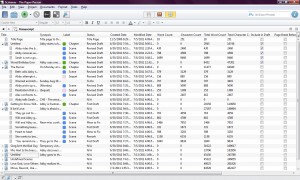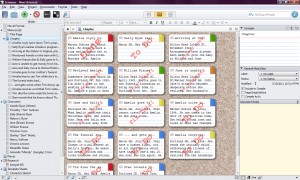Scrivener for Windows Review
When I found out Scrivener for Windows was in beta testing, I dropped everything to find out more about it. This writing software by Literature and Latte includes tons of cool features for writers, but until recently was only available to Mac-users.
Because I’m using a trial version and the developer is still actively collecting information to resolve existing issues, this review won’t comment on functionality. If you decide to download the trial version, remember that it is still in testing, expect bugs, and back up your work frequently.
That being said, there are creative pros and cons to this tool.
Panels and toolbars are attractive and clean. The Binder on the left provides quick navigation of chapters, scenes, research, and notes. The Inspector on the right houses the Synopsis, General Meta-Data, Document Notes, Document References, Keywords, and Snapshots. (Did you get all of that?) The wide center panel is reserved for the text editor and viewing modes. All these features can be tucked away with convenient one-click buttons, but if they overwhelm, there is also a full-screen view to block out distractions.
Templates
Scrivener for Windows comes with pre-made templates for script-writing, poetry and lyrics, short projects such as stories or essays, and book-length fiction and non-fiction manuscripts. The novel templates contain folders, sample index cards, and character and setting worksheets while the research proposal template provides a full framework and style guidelines. You can also create your own templates or use none at all.
Importing
The program accepts imported documents including .doc, .docx, .rtf, .html, and .txt file formats, making it simple to bring in your WIP. I wasn’t really expecting my Review Comments from Microsoft Word to come over, but they did without a problem. You can also import multiple existing files into one Scrivener project.
Although importing is crucial when you’re first starting to use Scrivener, eventually you’ll want to begin a project from scratch in it. I practiced using the program with a backburner-idea, one I hadn’t touched yet. The Corkboard view is handy for laying out scenes, concepts, and character notes on “index cards” – and just like physical index cards, you can add headings and color code them if you choose. When switching to the Outliner view, the index card headings become outline headings. The Scrivenings view is for writing and editing, and it allows experimentation with scene order. There are also horizontal and vertical split screen options for viewing different documents within a project at once or even utilizing two different viewing options (such as the Corkboard and the Scrivenings editor) at the same time.
The program affords flexibility for labeling, tracking completion status, and affixing keywords, and this is where I believe the greatest usefulness and danger lie. Use some or all of the features to track subplots, characters, themes, or anything else important, but be aware that it gives you lots of ways to “sharpen your pencils” and avoid actually writing anything. This program is chock full of clever tools to give writers creative structure and a variety of ways to view, group, and rearrange ideas in development. However, if your idea is already developed, it is not going to write the words for you.
For example, after diligently adding keywords to all my scene ideas, I used the Keyword Heads-up Display to search for two different plot lines. Viewing the index cards showed me that one plot line has its major points, while another needs additional pinches and resolution. Great information – now, to act on it!
Exporting
Of course, at the end of it all, you need to be able to get your finished product back out of Scrivener so you can submit it. The software offers the option to export a project into separate files in rich text, PDF, Word documents, Open Document format, web pages or PostScript for advanced formatting. Alternatively, the Compile feature creates one very basic submission-ready file based on the selected chapters and scenes. E-publishing authors should take note that .epub and .mobi file formats will not be supported for exporting in Version 1.0. “It is expected that these formats will be freely supported after the initial release,” according to Literature and Latte’s tutorial document.
Summary
Scrivener for Windows excels at organizing and categorizing bits of ideas into a composite big picture. It is fun to use and most of its features are easy to learn, but it doesn’t replace a good word processor and doesn’t aim to – and like most writing tools, it can foster hapless procrastination or great productivity.
It will be priced at $40 USD at release and will run on Windows XP, Windows Vista, and Windows 7 operating systems, according to the product web site. Learn more at http://www.literatureandlatte.

